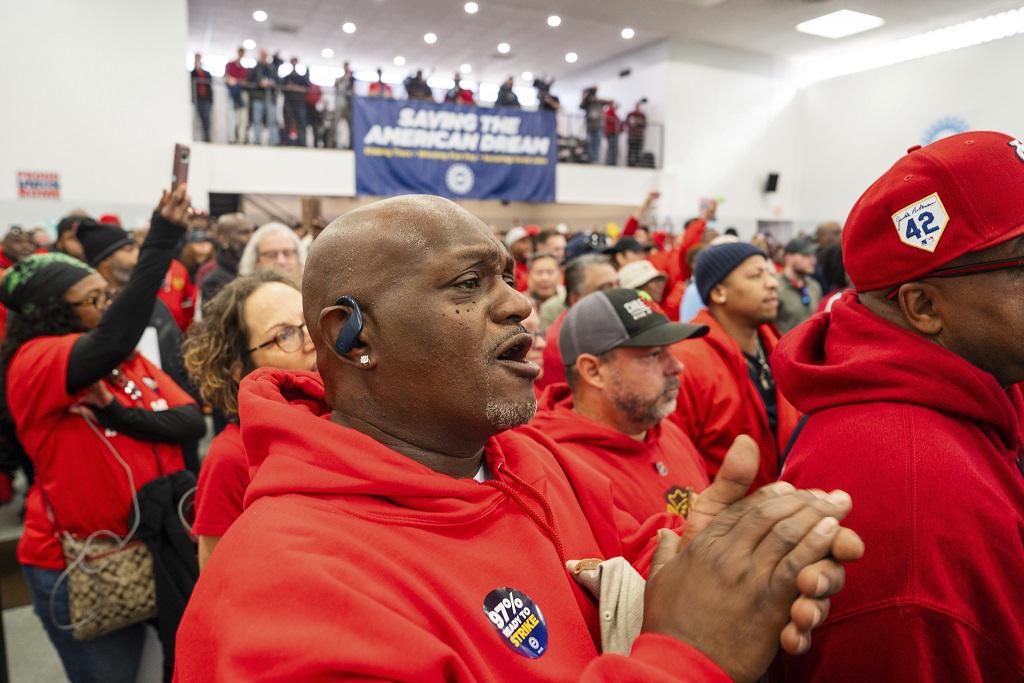Today on TAP: Building on workers’ historic victories in auto plants, delivery trucks, hospitals, campuses, and (maybe) Hollywood by Harold Meyerson
Read the full article on TAP here

The gap between that portion of the American workforce that has a union contract and that portion that doesn’t is beginning to widen again, as it largely hasn’t in recent decades. The landmark gains that the UAW has made in its contracts (yet to be voted on by members) with the Big Three, that the Teamsters secured with their UPS contract, and that health care support staff has made at Kaiser Permanente go far beyond the pay and benefits that workers receive at their non-union counterparts, including such firms as Tesla, Toyota, and Amazon.
The last three are all companies that the UAW or the Teamsters have effectively pledged to organize, and the contrast between their new pay scales and benefits and those of, say, Amazon and Tesla employees will doubtless be a major part of their sales pitches. Still, given all the loopholes in labor law that have enabled employers to fend off unions even when the vast majority of their workers want to join them, those sales pitches will be necessary but not sufficient to enabling such workers to actually go union.
What else is needed? Worker and community mobilization. A supportive government. Low unemployment. A pro-worker, anti-billionaire zeitgeist.
Both the UAW and Teamster victories owe a lot to those unions’ mobilization of their own rank and file to shut down plants (the UAW) or to credibly threaten a massive strike (the Teamsters). It’s no accident that both unions had new leaderships elected, as they had not been previously, by the rank and file, and that both those new leaderships had won election campaigning against an ancien régime. The actual accident, if we can term it that, was that both unions had experienced such egregious leadership corruption that the federal government, as part of the terms of its settlements with those unions, required them to abandon the practice of electing their leaders at delegated conventions (an almost universal practice throughout the union movement), and to switch to a vote of the general membership.
While a number (not a huge number) of unions today have dedicated and savvy convention-elected leaders, there’s now no gainsaying that enlisting the rank and file in leader selection can (can, not will) yield candidates more in touch with members’ frustrations and grievances, as well as a large cadre of members willing to walk the walk on picket lines to push for greater workplace gains. In the aftermath of their victories, both UAW President Shawn Fain and Teamster President Sean O’Brien can count on their respective unions’ cadres to join union staffers in organizing efforts at the big non-union companies.
That’s the first condition for rolling the union on. The second is a high level of community support. In many struggles for unionization, unions customarily enlist local clergy, elected officials, and such to join in the efforts. That’s a strategy to which unions need to devote even more resources than they currently do, particularly inasmuch as the level of popular support for unions is at a 50-year high.
Beyond that, they need the state to weigh in heavily on their side. That means not just having the president on a picket line, groundbreaking though that was, but also having the rules, under the National Labor Relations Act, devised to enable workers to collectively bargain strengthened so that, for the first time in half a century, they actually do that. That’s exactly what President Biden’s NLRB is now doing, with rulings that make it considerably harder for employers to thwart unionization when a majority of employees favor it.
They also need a government that understands how important a low rate of unemployment is to low-wage and working-class Americans, and how it also empowers unions. The Biden administration’s American Rescue Plan Act of 2021, by providing an economic stimulus that boosted purchasing power to the point that it squelched the expected recession, did just that.
While Democratic control of the White House and both houses of Congress following the 2024 election is not a sufficient condition for rolling the union on, it most surely is a necessary one. In hailing the UAW’s victory yesterday, Biden said, “Worker power—worker power—is critical to building an economy from the middle out and the bottom up.” Even as American progressives are currently focused on the Israel-Palestine conflict, they can’t lose sight of the class war in America, and still have to pose the “which side are you on” in that war question going into next year’s elections.